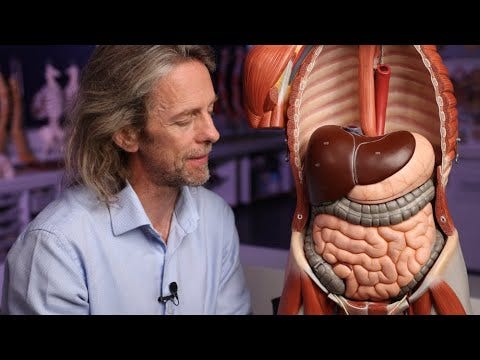General Structure and Function: The GI tract (alimentary canal) is a muscular tube running from mouth to anus. Its primary functions include digestion, absorption of nutrients, and excretion of waste. It begins as a simple tube in the embryo. The layers of the GI tract include the mucosa (inner layer) and muscular layers (longitudinal and circular muscles for peristalsis).
Digestion and Absorption Process: The oral cavity begins digestion with teeth, tongue, and salivary glands (enzymatic breakdown). The esophagus transports food to the stomach via peristalsis. The stomach is a muscular sac that uses acid and enzymes for protein breakdown. The small intestine consists of the duodenum, jejunum, and ileum, and is the primary site for nutrient absorption. The large intestine includes the cecum, ascending, transverse, descending, and sigmoid colon, and the rectum; it focuses on water and salt absorption, forming feces.
Key Structures and Functions: Teeth and tongue are involved in mechanical digestion and food manipulation. Salivary glands secrete saliva for enzymatic breakdown. The esophagus propels food to the stomach using peristalsis. The stomach facilitates chemical digestion using acid and enzymes (pepsin for proteins).
The small intestine has three parts:
Duodenum: Neutralizes stomach acid, receives bile and pancreatic enzymes. ○ Jejunum: Major site for nutrient absorption (villi and microvilli increase SA). ○ Ileum: Absorbs bile salts, vitamin B12, and remaining nutrients.
The large intestine absorbs water and salts, and forms and stores feces.
Additional Components: The liver and gallbladder produce and store bile for fat emulsification. The pancreas secretes digestive enzymes and bicarbonate. The appendix may help in repopulating gut bacteria post-illness.
Nervous and Blood Supply:
The Enteric Nervous System autonomously controls gastrointestinal functions.
The Autonomic Nervous System, using both its parasympathetic (via the vagus nerve) and sympathetic fibers, regulates digestive activities as well.
The blood supply includes:
Celiac Trunk: Supplies stomach, spleen, liver, and upper duodenum.
Superior Mesenteric Artery: Supplies small and part of the large intestine.
Inferior Mesenteric Artery: Supplies descending/sigmoid colon and rectum.
Sources:
Written by Churnika Gudla from MEDILOQUY



